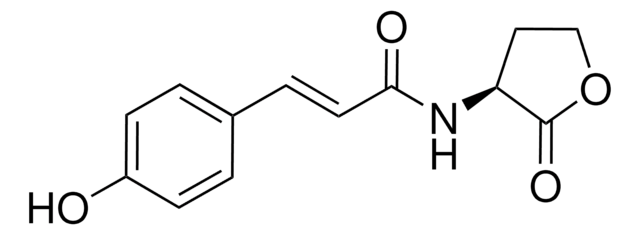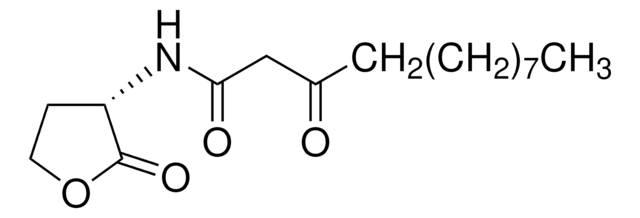51481
N-(3-Hydroxytetradecanoyl)-DL-homoserine lactone
≥96% (HPLC), carbon 64.7-67.3 %
Sinonimo/i:
3-Hydroxy-N-(tetrahydro-2-oxo-3-furanyl)tetradecanamide
Scegli un formato
Scegli un formato
About This Item
Prodotti consigliati
Saggio
≥96% (HPLC)
Composizione
carbon, 64.7-67.3%
nitrogen, 4.0-4.5%
Temperatura di conservazione
−20°C
Stringa SMILE
CCCCCCCCCCCC(O)CC(=O)NC1CCOC1=O
InChI
1S/C18H33NO4/c1-2-3-4-5-6-7-8-9-10-11-15(20)14-17(21)19-16-12-13-23-18(16)22/h15-16,20H,2-14H2,1H3,(H,19,21)
IKQUESGRCDRZTI-UHFFFAOYSA-N
Azioni biochim/fisiol
Confezionamento
Avvertenze
Danger
Indicazioni di pericolo
Consigli di prudenza
Classi di pericolo
Acute Tox. 3 Oral
Codice della classe di stoccaggio
6.1C - Combustible acute toxic Cat.3 / toxic compounds or compounds which causing chronic effects
Classe di pericolosità dell'acqua (WGK)
WGK 3
Punto d’infiammabilità (°F)
Not applicable
Punto d’infiammabilità (°C)
Not applicable
Scegli una delle versioni più recenti:
Possiedi già questo prodotto?
I documenti relativi ai prodotti acquistati recentemente sono disponibili nell’Archivio dei documenti.
I clienti hanno visto anche
Filtri attivi
Il team dei nostri ricercatori vanta grande esperienza in tutte le aree della ricerca quali Life Science, scienza dei materiali, sintesi chimica, cromatografia, discipline analitiche, ecc..
Contatta l'Assistenza Tecnica.















